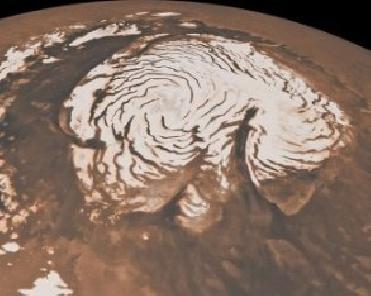
This image, combining data from two instruments aboard NASA’s Mars Global Surveyor, depicts an orbital view of the north polar region of Mars. A NASA photo
PASADENA (BNS): A renewed analysis of the varied geological shapes of the Martian ice cap in its northern polar region has helped scientists understand the sub-surface's enigmatic features which have evolved by wind millions of years ago.
Using data from NASA's Mars Reconnaissance Orbiter's Shallow Radar (SHARAD), a team of researchers has studied in greater detail the Chasma Boreale – a large gorge about as long as Earth's Grand Canyon but deeper and wider – and a series of spiral troughs in the northern ice cap of Mars.
“SHARAD is giving us a beautifully detailed view of ice deposits, whether at the poles or buried in mid-latitudes, as they changed on Mars over the last few million years,” said Rich Zurek, Mars Reconnaissance Orbiter project scientist at NASA's Jet Propulsion Laboratory in Pasadena, California.
According to some scientists, the Chasma Boreale was created when volcanic heat melted the bottom of the ice sheet and triggered a catastrophic flood. Others suggest strong polar winds carved the canyon out of a dome of ice.
About the troughs, scientists have propounded many theories about their formation. One of them states that as Mars spins, ice closer to the poles moves slower than ice farther away, causing the semi-fluid ice to crack. As per another mathematical model, increased solar heating in certain areas and lateral heat conduction could cause the troughs to assemble.
The new findings, however, suggest that both the canyon and spiral troughs were created and shaped primarily by wind. Rather than being cut into existing ice very recently, the features formed over millions of years as the ice sheet grew. By influencing wind patterns, the shape of underlying, older ice controlled where and how the features grew, NASA said.
“Nobody realised that there would be such complex structures in the layers.
“The layers record a history of ice accumulation, erosion and wind transport. From that, we can recover a history of climate that's much more detailed than anybody expected,” said Jack Holt, of the University of Texas at Austin's Institute for Geophysics.
The new findings appear in the May 27 issue of journal Nature.
 Previous Article
Previous Article Next Article
Next Article













The Indian Air Force, in its flight trials evaluation report submitted before the Defence Ministry l..
view articleAn insight into the Medium Multi-Role Combat Aircraft competition...
view articleSky enthusiasts can now spot the International Space Station (ISS) commanded by Indian-American astr..
view article